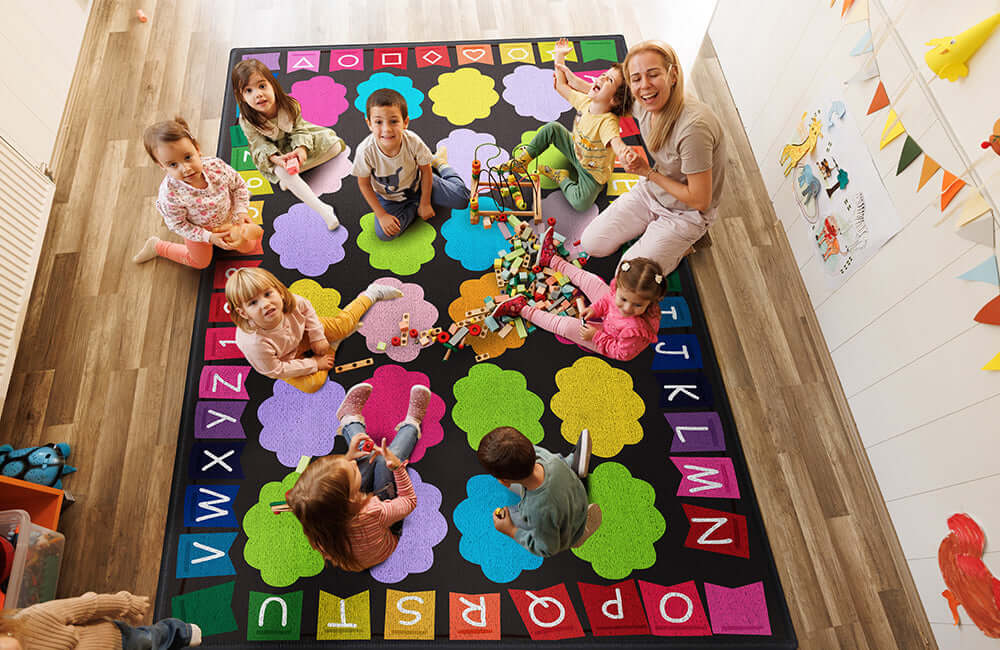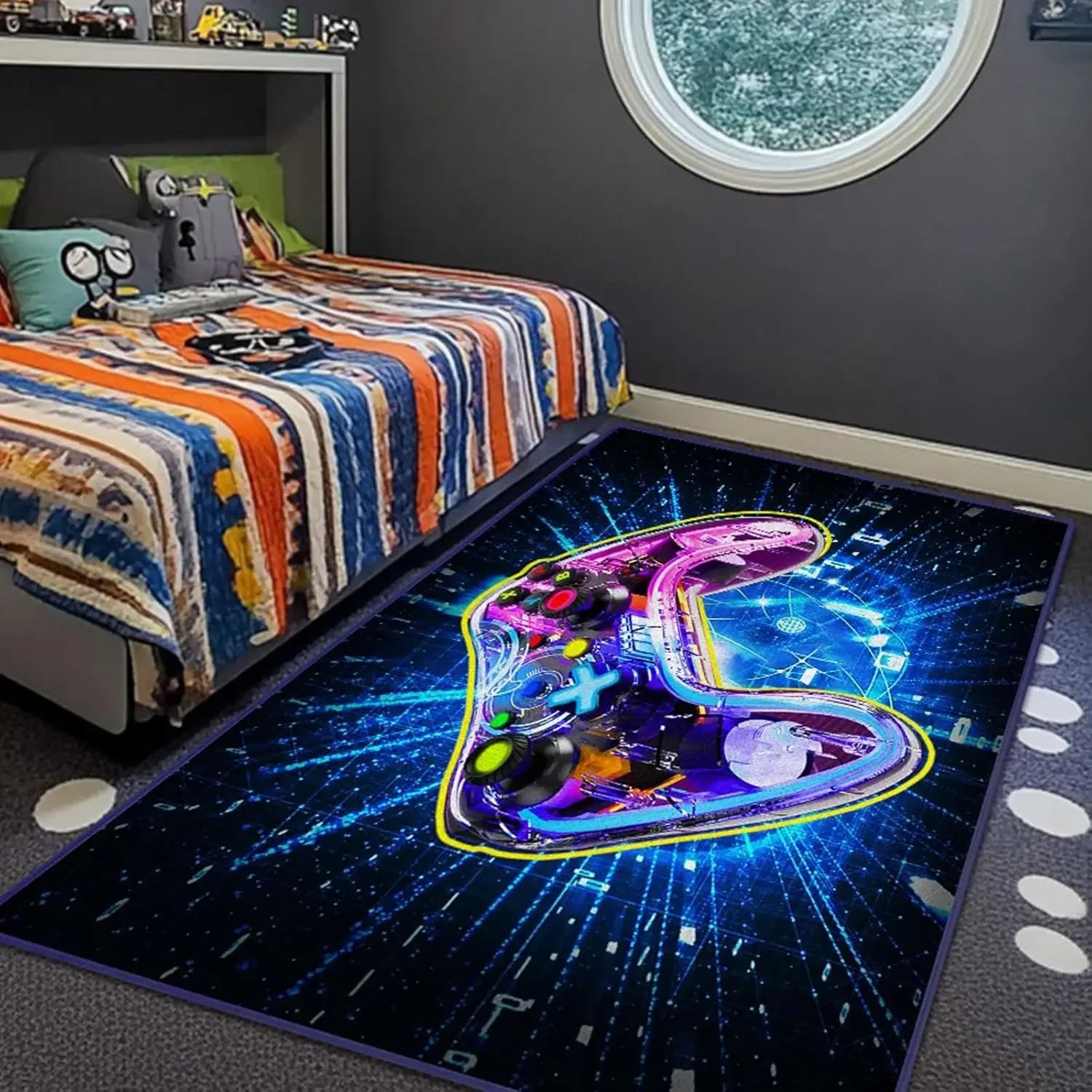Why Rug Size Matters for Kids' Spaces
The size of a rug in a child's room affects more than just appearance. According to interior design experts at Apartment Therapy, properly sized rugs create defined zones that help children understand the purpose of different areas. This spatial organization supports cognitive development and independence.
A well-sized rug can:
- Create a safe, cushioned area for play
- Define functional zones within a room
- Protect flooring from spills, scratches, and wear
- Reduce noise from running and playing
- Add warmth and comfort for floor-based activities
- Visually anchor furniture groupings
Too small, and the rug becomes a tripping hazard; too large, and it can overwhelm the space and be more challenging to clean. Getting the size right is essential for both function and style.
Measuring Your Space: The First Step
Before shopping for kids' rugs, you need accurate measurements of the available space. Here's how to approach this crucial first step:
- Measure the entire room - Get the full dimensions of the space where the rug will be placed. For standard rectangular rooms, measure the length and width. For irregular spaces, create a simple floor plan.
- Account for furniture placement - Note the position of fixed furniture like beds, dressers, bookcases, and play stations. This helps determine whether you need a rug that fits under furniture or just in open areas.
- Consider traffic patterns - Observe how your child moves through the space. Rugs should enhance, not hinder, natural movement.
- Allow for margins - Standard design practice suggests leaving 12-18 inches of bare floor between the rug edge and the wall for kids' rooms. This creates a pleasing border and prevents the rug from appearing like wall-to-wall carpeting.
- Think about growth - Children grow and their needs evolve. Consider how the space might change over the next few years when selecting rug dimensions.
Kids' Bedroom Rug Sizing Guide
The bedroom often requires the most strategic approach to rug sizing, as it needs to work with bed placement:
For Twin Beds:
- Small Option (4' x 6'): Place alongside the bed, covering the stepping area
- Medium Option (5' x 8'): Extends under the bottom third of the bed and outward
- Large Option (6' x 9'): Extends under half the bed, creating a generous play area
For Full/Double Beds:
- Medium Option (5' x 8'): Place at the foot of the bed for a landing area
- Large Option (6' x 9' or 8' x 10'): Extends under the bottom half or two-thirds of the bed
For Bunk Beds:
- Medium Rectangle (5' x 8'): Position alongside the ladder area and extend into the room
- Large Rectangle (6' x 9'): Creates a substantial play area adjacent to bunks
- Round Option (6' diameter): Perfect for creating a central play area when bunks are against walls
Research from Children's Environmental Health Network suggests that defined floor play areas contribute to better focus during play activities and easier transitions between activities.
Playroom Rug Dimensions
Playrooms demand rugs that can handle the most active use while clearly defining activity zones:
For Small Playrooms (Under 100 sq ft):
- 5' x 7' or 6' x 6' round: Creates a central play zone without overwhelming the space
- 4' x 6': Ideal for a reading corner or small activity zone
For Medium Playrooms (100-150 sq ft):
- 6' x 9' or 8' x 8' round: Covers a substantial play area
- Two 5' x 7': Creates separate zones for different activities
For Large Playrooms (Over 150 sq ft):
- 9' x 12': Anchors a large central area
- 8' x 10': Works well for area definition
- Multiple smaller rugs: Define distinct activity stations (art, reading, blocks, etc.)
According to Child Development Research, clearly defined play spaces help children develop better organizational skills and allow for more focused play. Using different rug sizes to create "zones" can support this developmental benefit.
Nursery Rug Considerations
Nurseries require special consideration, as the rug must accommodate tummy time, crawling, early walking, and adult movement around the crib:
Standard Nursery Rug Sizes:
- 4' x 6': Small nursery, positioned alongside the crib
- 5' x 7': Medium nursery, covering the central activity area
- 6' x 9': Larger nursery, accommodating multiple furniture pieces
A study from The Journal of Pediatrics found that soft, cushioned surfaces in appropriate sizes can encourage more floor time for infants, which is crucial for motor development.
For nurseries, consider these placement options:
- Under the crib: Choose a rug large enough to extend at least 24" beyond the crib on all accessible sides
- Activity area: Position in the room's center, leaving space for a rocking chair or glider
- Changing area: A small 3' x 5' rug can create a dedicated zone near the changing table
<a id="activity-based-sizing"></a>
Activity-Based Sizing
Different activities require different rug dimensions. Consider your child's favorite pastimes when selecting the right size:
Reading Nooks:
- 4' x 6' or 4' round: Creates a cozy, dedicated reading space
Building Block Areas:
- 5' x 7' or 6' x 6' round: Provides contained space for constructions
Board Games and Puzzles:
- 6' x 6' square or round: Offers ample room for game boards and pieces
Active Play:
- 8' x 10' or larger: Allows for movement, tumbling, and imaginative play
Arts and Crafts:
- 5' x 7': Contains mess while providing workspace
According to early childhood experts, dedicated spaces for specific activities help children develop better focus and self-regulation skills. Appropriate rug sizing contributes significantly to this environmental organization.
Common Mistakes to Avoid
When sizing kids' rugs, watch out for these common pitfalls:
1. The Postage Stamp Effect
Tiny rugs floating in the middle of large rooms create tripping hazards and look out of proportion. Always choose a rug large enough to accommodate at least the front legs of key furniture pieces.
2. Wall-to-Wall Misconception
Contrary to popular belief, kids' rugs don't need to cover the entire room. Leaving 12-18 inches of floor visible around the perimeter creates a more balanced look.
3. Ignoring Growth Potential
Children grow quickly, and their play styles evolve. A rug that's perfect for a crawling baby may be inadequate for an active preschooler. Consider investing in a size that will accommodate changing needs.
4. Overlooking Traffic Patterns
Placing rug edges in high-traffic pathways invites tripping and faster wear. Map your child's movement through the room and size accordingly.
5. Neglecting Furniture Arrangement
For optimal balance, either place all furniture legs on the rug or all legs off—the "front legs only" approach works for most kids' rooms.
Rug Layering for Kids' Rooms
Layering rugs has become a popular technique to maximize both function and style in children's spaces. This approach allows for:
- More defined activity zones
- Added cushioning for play areas
- Seasonal adjustments (adding warmer layers in winter)
- Easy refreshing of the room's look without replacing larger base rugs
According to design experts at Domino, successful layering typically involves:
- A larger, neutral base rug (8' x 10' or 9' x 12')
- Smaller, more colorful or textured accent rugs (3' x 5' or 4' round)
- At least 12" of the base rug visible around the perimeter of accent rugs
This technique works particularly well in shared sibling spaces, where different zones can be clearly defined while maintaining a cohesive look.
Cleaning and Maintenance Based on Size
Rug size significantly impacts cleaning and maintenance requirements—an important consideration for busy parents:
Small Rugs (Under 5' x 7'):
- Easier to shake out or wash
- Can often fit in home washing machines
- Simple to rotate for even wear
- Easy to replace seasonally or as interests change
Medium Rugs (5' x 8' to 8' x 10'):
- May require partial furniture removal for thorough cleaning
- Often need professional cleaning for full washing
- Benefit from regular vacuuming and spot treatment
Large Rugs (Over 8' x 10'):
- Require professional cleaning
- Difficult to shake out or move for cleaning
- Need regular maintenance to prevent dirt buildup
- More significant investment, so durability becomes more important
For kids' spaces, The American Academy of Pediatrics recommends regular cleaning of floor coverings to reduce allergen exposure. Selecting a rug size that you can realistically maintain is an important health consideration.
FAQs About Kids' Rug Sizing
Q: How often should I replace my child's rug as they grow? A: Quality rugs can last 5-7 years with proper care. Consider reevaluating size needs during major transitions (crib to bed, adding a study desk, etc.).
Q: Should siblings with a shared room have one large rug or separate rugs? A: For shared spaces, either approach can work. One large rug (8' x 10' or larger) creates cohesion, while separate rugs (5' x 7' each) help define personal spaces. The best choice depends on room layout and the children's ages and preferences.
Q: Are round rugs practical for kids' rooms? A: Round rugs work beautifully in kids' spaces! They're ideal for central play areas, reading nooks, and rooms with unusual angles. A 6' or 8' diameter round rug creates a natural gathering spot for play.
Q: What's the minimum rug size that's practical for a kids' room? A: For functionality, we recommend nothing smaller than 4' x 6' for kids' spaces. Anything smaller tends to shift position easily and becomes more of a tripping hazard than a useful addition.
Q: How do I size a rug for a room with multiple beds? A: For rooms with two twin beds, consider either one large rug (8' x 10') positioned between and extending under both beds, or two identical 5' x 7' rugs, one for each bed area.
Conclusion
The perfect rug size creates the foundation for a functional, beautiful children's space. By considering room dimensions, furniture placement, activity needs, and growth potential, you can select a rug that will serve your child well for years to come.
At Booom Jackson, we offer a wide selection of kids' rugs in all the sizes discussed in this guide. Browse our collection to find the perfect fit for your child's unique space and personality.
Remember: the right rug doesn't just add color and comfort—it creates the stage where childhood memories are made, one play session at a time.








Leave a comment
This site is protected by hCaptcha and the hCaptcha Privacy Policy and Terms of Service apply.